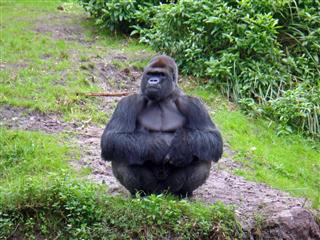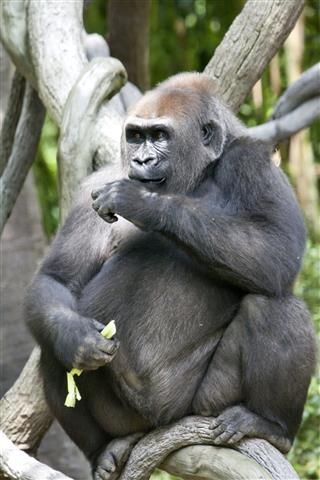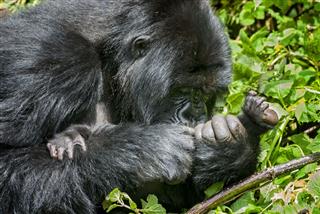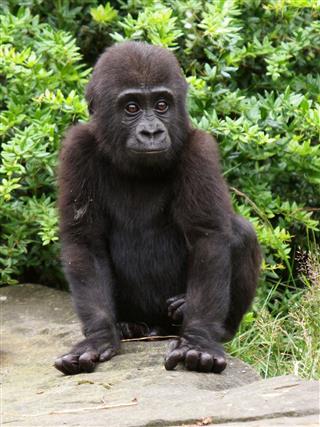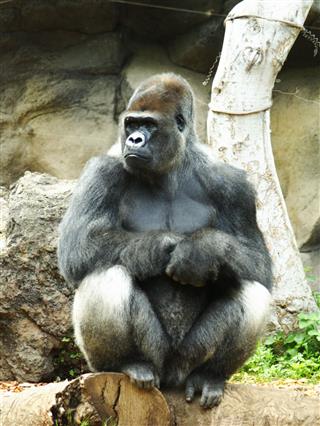
Though, it is a fact that the rainforest is home to 40 – 75 percent of the total organisms worldwide, many animal species are listed in the IUCN Red List. Here are some rainforest animals that are endangered.
Animals are categorized under endangered species if they are at risk of becoming extinct either because of their few numbers or due to the change in the environmental condition. As per the International Union for Conservation of Nature and Natural Resources (IUCN) data, about 40 percent of the total organisms are on the verge of extinction in the near future.
In 1963, the IUCN created the Red Data List of more than 15,500 species, after evaluating the extinction risk of various species and subspecies worldwide. This list is also known as IUCN Red List of Threatened Species or IUCN Red List.
Among the many ecosystems, rainforests are those forest areas that are characterized by heavy rainfall (1750 – 2000 mm). They represent one of the richest ecosystems on Earth and are referred to as the ‘Jewels of the Earth’. It is estimated that more than 50 percent of the total animal species are native to the rainforests. However, due to climate change and human encroachment of land, many of these animals are endangered or threatened.
Types of Endangered Rainforest Animals
Gorilla
Scientific Name: Gorilla gorilla
IUCN Red List Category and Criteria: Critically Endangered A4cde ver 3.1
About
Classified as a critically endangered species, an estimated 80 percent of the gorilla population has become extinct in the last three generations (one generation spans for approximately 22 years). The causes for its declining population are commercial hunting, change in habitat quality due to logging, and disease-induced mortality. Moreover, the gorillas have a very low reproductive rate which further contributes to the problem.
The gorilla is most abundant in the rainforests of West Central Africa. It is found primarily in the lowland tropical forests and swamp forests.
Conservation Efforts
Although there are a number of international and national laws for protection of these animals, the enforcement has not been very strict. In 1991, International Gorilla Conservation Programme (IGCP) was formed by African Wildlife Foundation (AWF), Fauna & Flora International (FFI) and the World Wide Fund for Nature (WWF). The main goal of this conservation program is to conserve the endangered mountain gorillas by reducing the threat to the forest habitat and collaboration with the protected area authorities in the areas set up for gorilla preservation.
Sumatran Orangutan
Scientific Name: Pongo abelii
IUCN Red List Category and Criteria: Critically Endangered A2cd ver 3.1
About
The Sumatran Orangutan is listed in the critically endangered species as the population decline is estimated to about 80 percent in the last 75 years. They are found in the Southeastern Tropical and Subtropical Broadleaf forests of Sumatra and Borneo. Habitat destruction due to conversion of forests to oil palm plantations and agricultural land and hunting are major threats to orangutans.
If approved Ladia Galaska road network in Aceh province could further cause habitat destruction for these animals. In addition to this the orangutans are hunted and captured in the wild to be kept as pets.
Conservation Efforts
This critically endangered species is protected by the Appendix I of CITES and is strictly protected under Indonesian domestic legislation (UU No 5/1990). In addition to this the Leuser Ecosystem supporting nearly 75 percent of the Sumatran Orangutans was inaugurated by Presidential Decree in 1998 to provide a sustainable living habitat for the orangutans.
Sumatran Rhinoceros
Scientific Name: Dicerorhinus sumatrensis
IUCN Red List Category and Criteria: Critically Endangered A2abd; C1+2a(i) ver 3.1
About
One of the smallest rhinoceros, the Sumatran Rhinoceros stands 112-145 cm high at shoulders, has two horns and has a thin coat of reddish brown hair. These animals are extremely solitary and can be seen with others in their species during courtship and child-rearing. The population of this species has dwindled to an alarming 275 individuals. Earlier found in the rainforests and swamps of India, Thailand, Bhutan, Indonesia and Malaysia, the population is now restricted to Sumatra and Borneo.
The severe declines of greater than 80% over three generations has led to animal becoming near extinct. Major threats to the species include poaching and hunting for rhino horns and other body parts.
Conservation Efforts
The species is protect legally in all range states. An international cooperative program involving the countries Indonesia and Malaysia which seeks to bring forth deploy effective anti-poaching measures have been undertaken.
Javan Rhinoceros
Scientific Name: Rhinoceros sondaicus
IUCN Red List Category and Criteria: Critically Endangered C2a(i); D ver 3.1
About
One of the rarest animals on the planet today, the Javan Rhinoceros is on the brink of extinction with only 50 of these species in the wild and none in captivity. Very similar to the one-horned rhinoceros but with a far smaller head and overall size, the Javan rhinoceros inhabits rainforests with a good supply of water and mud wallows. Of the three subspecies of this rhinoceros, only 50 Indonesian Javan rhinos survive on the Ujung Kulon peninsula in western Java, Indonesia.
The excessive demand for rhino horn, poaching and diseases have led to a huge reduction in the population of this species.
Conservation Efforts
Apart from being legally protected in all range States, the Rhino Protection Unit (RPU) has been set up to protect these animals in two protected areas which include the Ujung Kulon National Park on Java and the Cat Loc part (Dong Nai province) of the Cat Tien National Park in Vietnam.
Golden Lion Tamarin
Scientific Name: Leontopithecus rosalia
IUCN Red List Category and Criteria: Endangered B1ab(iii) ver 3.1
About
The Golden Lion Tamarin Monkey (Leontopithecus rosalia) is found in the lowland coastal region of the state of Rio de Janeiro, Brazil. It is included in the endangered animals list as the extent of its occurrence is less than 5,000 km². Known for its bright reddish-orange fur and the claw-like nails also known as tegulae, this animal inhabits the lowland seasonal rain forest of the Atlantic coast of Brazil 1,500 mm a year.
The population of these monkeys is confined to three small areas of the tropical rain forest in southeastern Brazil with majority of damage to the population caused by humans hunting for its magnificent fur. Apart from illegal poaching, mining, urbanization and infrastructure development has led to a decline in the population.
Conservation Efforts
In 1996 this animal was listed as critically endangered by IUCN. However, thanks to the conservation efforts for thirty years the animal has been listed in the endangered list as opposed to being critically endangered and almost extinct. The first conservation efforts were taken by Adelmar Coimbra-Fillho and Alceo Magnanani in the late 1960s who started doing field surveys and established a breeding program.
In 1972 the Golden Lion Tamarin Conservation Program (GLTCP) was set up to encourage conservation of these primates. In addition to this various reserves like the Poço das Antas and União Biological Reserves help in maintaining a stable population of these animals. In 1990 set up the International Committee for the Conservation and Management of lion Tamarins to protect this species from extinction.
Chimpanzee
Scientific Name: Pan troglodytes
IUCN Red List Category and Criteria: Endangered A4cd ver 3.1
About
Chimpanzees are found almost all over the world, especially in the African forests. Found mostly in wet and dry forests these omnivorous primates live in social communities of five to 150. Though the chimpanzee is a widespread and abundant species of apes, their population has declined in the past few decades, mainly because of human exploitation, and loss of habitat due to slash and burn agriculture and gas mining and logging.
Poaching for pet trade, meat or even to protect crops has also lead to a dwindling chimpanzee population. Sometimes diseases and epidemics like the Ebola hemorrhagic fever can also cause a decline in chimpanzee populations.
Conservation Efforts
There is a law to killing chimpanzees in all countries. They are also found in protected wildlife preserves. However, stricter enforcement of these laws are needed to protect these apes from extractive industries and commercial hunting. In addition to this, surveys and major conservation actions are needed to avoid the spread of epidemics like Ebola.
Bengal Tiger
Scientific Name: Panthera tigris ssp. tigris
IUCN Red List Category and Criteria: Endangered A2bcd+4bcd; C1+2a(i) ver 3.1
About
The Bengal tiger is mostly found in India particularly in the evergreen and monsoon forests. It is also found in Bhutan, Bangladesh, and Nepal. According to biologists, poaching, hunting, and habitat loss are the primary causes for decline in its population. The loss of natural prey like antelopes and deer are also a cause for concern. Besides Bengal tiger, the global population of other tiger species is decreasing at an alarming rate. In the 20th century 3 tiger species have become extinct.
Conservation Efforts
In 2000, WWF initiated the Terai Arc Landscape by working with the governments of India and Nepal to reconnect 11 protected areas through wildlife corridors. Besides this WWF has also worked with local partners to curb poaching and stop trafficking of tiger parts.
Proboscis Monkey
Scientific Name: Nasalis larvatus
IUCN Red List Category and Criteria: Endangered A2cd ver 3.1
About
Also known as the long-nosed monkey, this primate species is listed as Endangered because of the drastic population reductions that are caused by hunting and habitat destruction. The species generally inhabit the mangrove, lowland, riverine and swamp forests of Brunei, Indonesia (Kalimantan) and Malaysia (Sabah and Sarawak). The encroachment of human population into their coastal and riverine habitat poses a major threat to this species.
Conservation Efforts
This species is protected under the CITES Appendix I and is known to occur in 16 protected areas like Muara Kaman Nature Reserve, Gunung Pueh Forest Reserve, Danau Sentarum Wildlife Reserve, Gunung Palung Nature Reserve and Kendawangan Nature Reserve. Unfortunately a number of factors including institutional deficiencies and lack of funds have led to a decline in their population over the years.
Indian Wild Dog
Scientific Name: Cuon alpinus
IUCN Red List Category and Criteria: Endangered C2a(i) ver 3.1
About
Also known as the Asiatic Wild Dog or Dhole, the Indian wild dog population has drastically dwindled to less than 2500 individuals in the wild. Depletion of their prey base, habitat loss and diseases from domestic and other dogs are the main threats to the species. These dogs prefer the moist and dry tropical forests of India. Apart from India, these wild dogs are also found in Bhutan, Cambodia, Lao PDR, Myanmar, North Korea, Thailand, Tibet, and Vietnam.
Conservation Efforts
In India, the Dhole is protected under the schedule 2 of the Wildlife Act of 1972 and in Cambodia many wildlife decrees restrict the hunting of these species. However significant conservation efforts especially towards maintaining the prey base has not been undertaken.
Giant Panda
Scientific Name: Ailuropoda melanoleuca
IUCN Red List Category and Criteria: Endangered C2a(i) ver 3.1
About
One of the most powerful symbols of species conservation in the world, the Giant Panda populations are confined to south-central China. The population in wild in 2004 was around 1600 individuals and 300 in captivity. These peaceful members of the bear family live in broadleaf and coniferous forests with a dense understory of bamboo.
This black-and-white bear has characteristic white patches around the eyes and a dense, wooly coat. They survive mainly on bamboo. The main threats to their population is posed by habitat destruction and their reliance on bamboo for food which is subject to periodic, synchronous flowering and die-off (at intervals of 15-120 years).
Conservation Efforts
The Giant Panda is protected under Category 1 (maximum level of protection) of the Chinese Wildlife Conservation Law of 1988 and on Appendix I of CITES. The WWF along with Chinese Ministry of Forestry have established a joint conservation program to protect these endangered animals. With poaching in control, the habitat restoration continues to be a major part of the conservation initiatives.
Giant Otter
Scientific Name: Pteronura brasiliensis
IUCN Red List Category and Criteria: Endangered A3cd ver 3.1
About
The largest of the thirteen otter species, the Giant Otter is found in the rainforests of South America especially in slow moving rivers and streams of Amazon, Orinoco, and La Plata River systems. Although they have very few natural predators, the Giant Otter population is greatly threatened by water pollution from mining, over-fishing of their prey and illegal hunting for their pelt. The current wild population is an estimated 1,000-5,000 individuals.
Some diseases like canine distemper or parvovirus can affect these animals leading to a great reduction in their numbers.
Conservation Efforts
Protected areas in South America like the Alto Purús National Park, in Peru and others in Suriname are the key to conserving the species habitat.
Asian elephant
Scientific Name: Elephas maximus
IUCN Red List Category and Criteria: Endangered A2c ver 3.1
About
The largest living land animals in Asia, the Asian elephant is under threat thanks to habitat loss, degradation, and fragmentation. Expanding human population that have encroached on elephant territories has led to conflicts and killing of these animals. Smaller in size as compared to African elephants, these animals have a distinctive trunk, tusks and ears with dorsal fins folded inwards. Tropical evergreen forests moist and dry deciduous forests serve as home for these animals.
Conservation Efforts
Although the species is listed under the CITES Appendix I, conservation efforts need to be undertaken to maintain the elephant’s habitat, avoid human-elephant conflicts and prevent ivory trading.
Endangered Rainforest Species
Classified as Critically-Endangered
• Philippine Cockatoos
• Philippine Eagle
• Regent Honeyeater
• Kakapo Parrot
• Sharp Snouted Day Frog
• Rancho Grande Harlequin Frog
• Poison Dart Frog
• Panamanian Golden Frog
• Golden Mantella
Classified as Endangered
• Swift Parrot
• Waterfall Frog
• Common Mist Frog
• Great Green Macaw
Considering the present scenario, the list of endangered animals is expected to grow in the coming years. Though there is no doubt that endangered animals are protected through various laws, organizations, and treaties, like the Convention on the International Trade in Endangered Species (CITES), more public awareness programs should be implemented to gain public notice. This way, we can protect animals from extinction and conserve the biodiversity of nature.Animals are categorized under endangered species if they are at risk of becoming extinct either because of their few numbers or due to the change in the environmental condition. As per the International Union for Conservation of Nature and Natural Resources (IUCN) data, about 40 percent of the total organisms are on the verge of extinction in the near future. In 1963, the IUCN created the Red Data List of more than 15,500 species, after evaluating the extinction risk of various species and subspecies worldwide. This list is also known as IUCN Red List of Threatened Species or IUCN Red List.
Among the many ecosystems, rainforests are those forest areas that are characterized by heavy rainfall (1750 – 2000 mm). They represent one of the richest ecosystems on Earth and are referred to as the ‘Jewels of the Earth’. It is estimated that more than 50 percent of the total animal species are native to the rainforests. However, due to climate change and human encroachment of land, many of these animals are endangered or threatened.





































